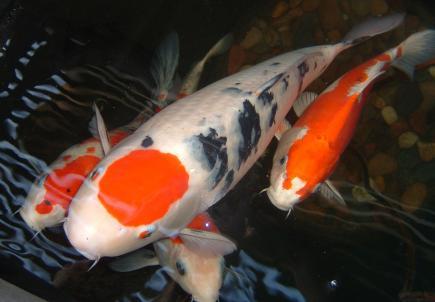 To maintain a healthy pond during the winter, preparation in autumn is necessary.
To maintain a healthy pond during the winter, preparation in autumn is necessary.
Start in September for healthy fish
Add drops of fish vitamins onto the food, letting it soak in for a few minutes before feeding the fish. Repeat every 10 days to help fish build strength. Feed fish through October as long as water temperatures remain at 8°C (46°F).
October/November
Plant maintenance is important for better water quality and a better environment for oxygenating plants. Carefully remove leaves, decayed plant parts and sludge and add it to the compost pile. Prune back reed/tube-like plants to just above the height of the water. These plants co-aid in gas exchange. Use a rake and pond vacuum to thoroughly clean the sludge from the bottom of the pond. Lower all hardy water plants to below the "freezing line" (about 60 cm). Overwinter tropical water plants indoors and plant bog plants in the garden.
Water maintenance is important for hibernating fish. 30 per cent of the volume of water contained in the pond must be changed. Top up with fresh water and condition the water to neutralize the chlorine.
Preparing the fish
- If the pond is 100 cm deep or more, the fish will be able to hibernate outdoors. GAS EXCHANGE is of ultimate importance and can be done using:
- floating pond de-icer;
- insulated air diffuser; and
- water pump
NEVER HAMMER HOLES INTO THE ICE AS THE VIBRATIONS FRIGHTEN THE FISH AND MAY CAUSE HARM.
- If the pond is 75 to 100 cm deep, follow step 1 but add insulating materials around and over the pond to protect the system from harsh winter temperatures. Straw or styrofoam can be used, along with plywood to cover the pond. Remember, do not cover completely as oxygen is still required.
- If the pond is less than 75 cm deep, fish must be overwintered indoors to ensure a safe environment at 50 to 70°C. Do not overstock aquarium. Make sure the aquarium is equipped with sufficient oxygen and filtration systems.
Be ready in the spring to test the water and conduct some "spring cleaning!"
NEVER FEED THE FISH UNTIL TEMPERATURE RISES TO 10°C AND ABOVE. IF FISH APPEAR NEAR THE SURFACE IN THE SPRING, THEY MAY NEED OXYGEN — ACT QUICKLY TO ADD OXYGEN AND ADD WATER SLOWLY TO HELP "DE-ICE" THE SURFACE IF FISH ARE TRAPPED.